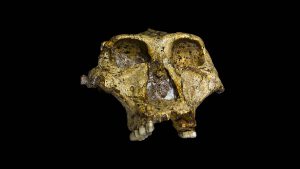
This species belongs to a group that represents a side branch of the human family tree. The paranthropines are a group of three species that range in time from around 2.3 up to around 1.2 million years ago. P. robustus is known from South Africa, while the other two species in the group (P. aethiopicus and P. boisei) are known from eastern Africa. The paranthropines as a group are clearly very specialized, being characterized by cranial adaptations for extreme chewing abilities. The name Paranthropus means “beside man” and was intended to highlight the interpretation that members of this group were not directly ancestral to modern humans.
P. robustus was first discovered by Robert Broom in 1938. Broom was seeking more hominid specimens after the discovery of Australopithecus africanus at Sterkfontein in 1936. A local school boy showed him some fossil teeth that had been found at an area just down the road from Sterkfontein. These teeth were from a hominin that was different from A. africanus, and Broom began investigation at this new site of Kromdraai. He and his team recovered numerous teeth and cranial fragments from this hominin species. Ten years later, another site in the Sterkfontein Valley, Swartkrans, yielded hominin fossils that have also been attributed to P. robustus. Since that time, at least one other site in South Africa, Drimolen, has yielded remains of P. robustus. All of these remains have been dated by biostratigraphy to between 2.0 and 1.2 million years ago.
The cranial anatomy of P. robustus is distinctive for the large, dished face, the prominent cheek bones, the small front teeth, the very large cheek teeth, and the large, deep mandible. Males are larger than females and have a sagittal crest running along the top of their skull. These traits are interpreted as indicating a chewing apparatus that is adapted for eating tough, hard foods.
Very little is known about the postcranial skeleton of P. robustus because few fossil bones can be unambiguously attributed to this species. Habitat reconstructions of Swartkrans indicate wooded grassland and edaphic grasslands, supporting the suggestion that Paranthropus might have exploited resources in wet grasslands.